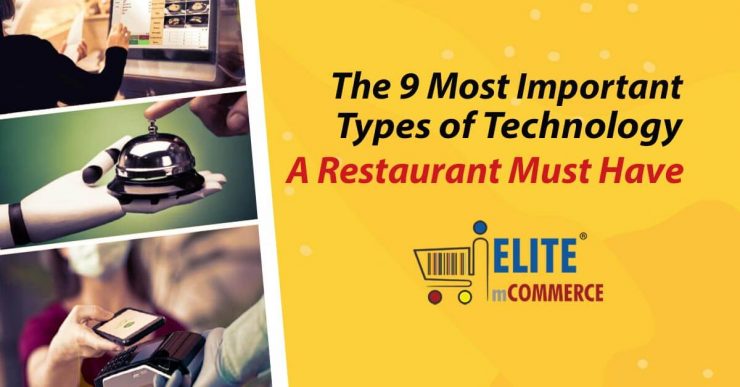New technologies have the potential to reshape how restaurants do business and serve their customers. Whether it’s taking advantage of digital solutions to connect with customers, process payments, improve efficiency in the kitchen, or assure quality in food production and service, technology can improve your restaurant. Keep track of the most promising developments in technology and determine whether they will bring convenience to your operations.
Touchscreen Point of Sale Terminals
Point-of-sale terminal technology has advanced significantly in the past few years. Touchscreen-based terminals are lighter and more portable, have an intuitive interface that customers can use to swipe cards, enter signatures, and add tips or other additions. They need to be durable and stay connected at all times so customers can pay.
POS terminals that are handheld can be brought to the table rather than requiring staff to take cards and process transactions at the counter, reducing labour costs.
Contactless Payments
In the wake of the COVID-19 pandemic, customers are conscious of where germs can come from. Offering contactless payments from newer tap-to-pay cards and mobile phone payment apps that can send wireless payments will assure customers that they will be safe while dining out. Visa reported adding 80 million contactless cards in the US. This may require upgrading your POS systems to receive contactless transactions, but it is worth it to allow quicker, safer, and more convenient payment from your customers.
Order at the Table
Ordering systems are a great tool to speed up food orders at the table or the front counter. Being able to order meals at your own convenience is appealing to many parties, sends the orders to the kitchen rapidly, and ensures that orders are not messed up. It also helps waitstaff run multiple tables at once.
A digital menu or touchscreen device can be used to let customers place their orders, potentially using the same interface as a mobile app.
Self-Ordering Kiosks
For quick-service restaurants and fast-casual dining, self-order cuts down on lines and provides convenience to customers, letting them order their food themselves without feeling time pressure. Letting customers create their own orders reduces the potential for complaints about incorrect orders and helps the kitchen know what to work on next. This can shorten lines, attract more customers, and incentivize larger orders by giving customers more opportunities to consider appetizers, beverages, and desserts.
Kitchen Display Systems
Keeping track of orders in a busy kitchen and organizing food preparation so a party’s orders can be ready all at once and on time can be difficult. A display screen in the kitchen that feeds directly from the POS system is always accurate and easier to read and reference than printed tickets. In addition, it updates in real-time, letting kitchens get a jump start on food preparation rather than waiting for orders to be inputted.
Unlike tickets, the digital display of current customer orders can’t be misplaced or damaged, which would lead to delays or mistakes. A kitchen display system should be mounted in a convenient location in the kitchen where your staff can reference it quickly and adjust it as orders are fulfilled. Having a digital display improves the quality of your service and leads to less stressed employees and happier guests.
Read also:- Restrict your Restaurant Menu on Third-party Food delivery apps
High-tech cash drawer
As long as customers still pay with cash, a cash drawer that’s secure and easy to handle will play a role in payments. Newer models make it easier to get the right amount of change and will record transactions to integrate with your POS system, saving time from data entry and reducing the number of time customers spend waiting to complete their transactions.
Inventory management system
43% of small businesses either don’t track their inventory or do so through a manual process, according to Wasp Barcode’s research. A digital inventory management system lets you know if ingredients are running low without requiring employees to spend time counting. It can help you avoid waste, keep up with expiration dates, and track supplier prices as they change, saving you money. An inventory management system that integrates with your POS system and accounting software drastically simplifies the process of tracking the inflow and outflow of cash to your business.
Integrated Online Ordering Solutions
Online ordering is becoming a core element of many restaurants’ business. A mobile restaurant ordering app can be used to let customers order pickup or home delivery from your menu. While third-party platforms like Doordash and Grubhub dominate online delivery, having your own app gives you more control over your menu and presentation, increases the amount of profit that goes directly to your business, and lets you get POS integration with your restaurant’s other technology. This cuts down on the amount of work needed to track overall orders and payments from multiple sales channels.
Guest engagement systems
Modern data collection can play a huge role in bringing customers back for more. Guest engagement and loyalty systems can track customers, their orders and spending habits, and offer loyalty rewards for visiting and ordering from your restaurants. Get insights into common customer habits so you can meet their needs. Guest loyalty systems can be integrated with your mobile app and POS system so customers can be reminded of the loyalty rewards they can claim, while you can accurately track each customer.
Implementing tools like these to upgrade your restaurant technology will make running your business easier and increase your ability to reach out to your customers. A smoother overall restaurant experience will raise customer satisfaction for popular, modern restaurants.









Add comment